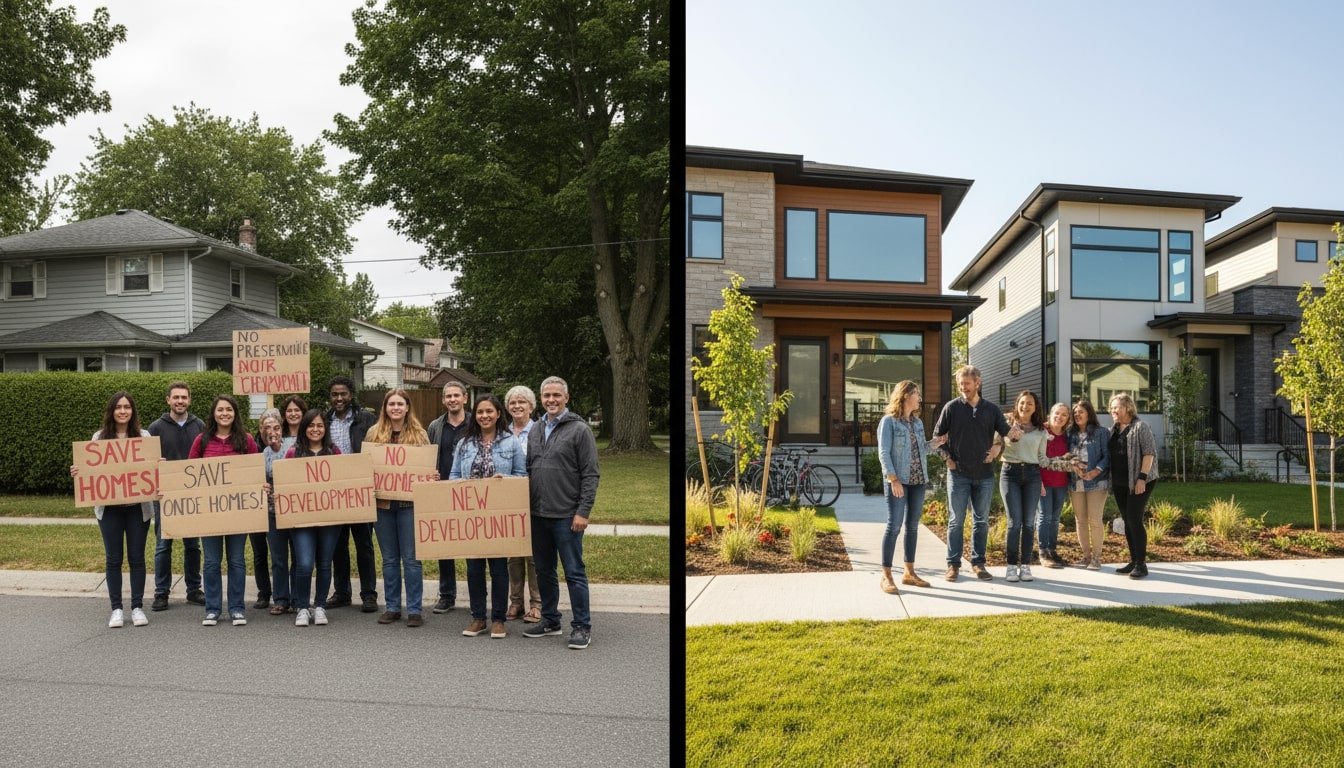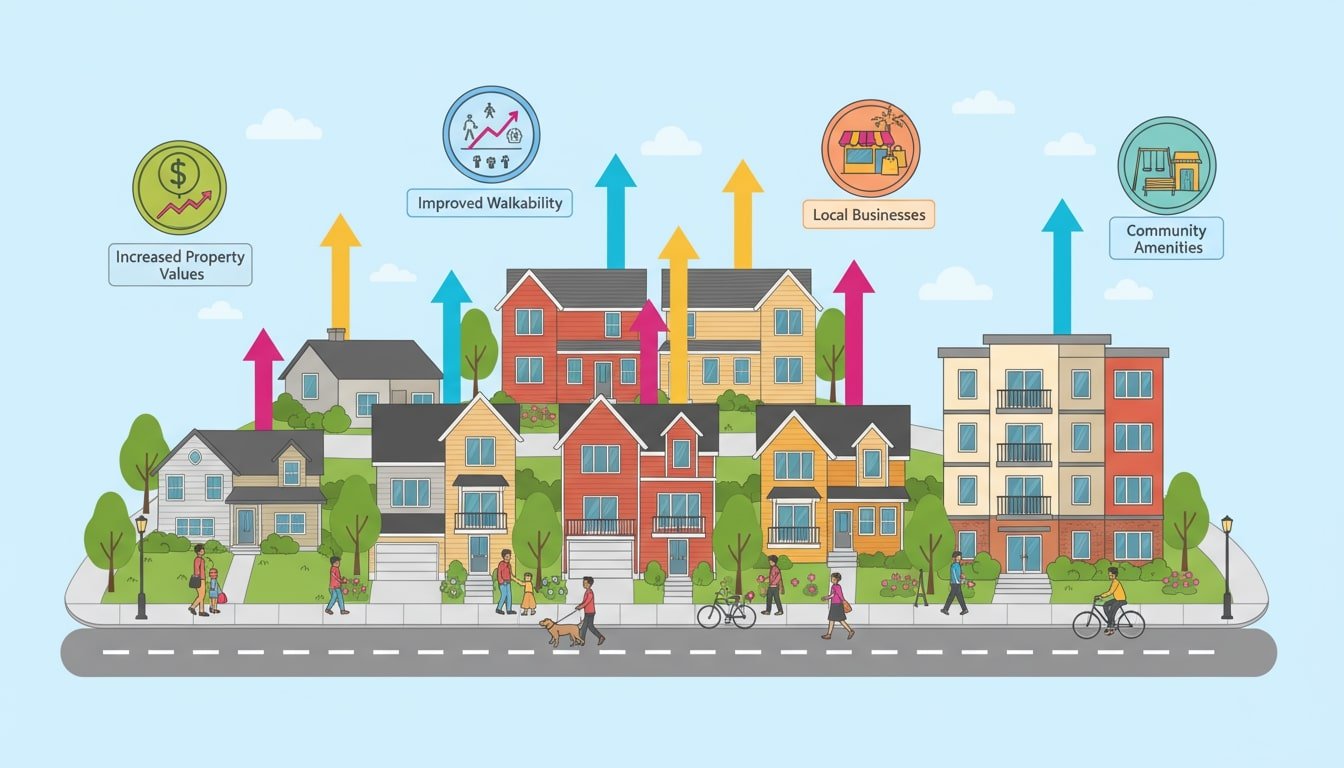Last Updated on November 17, 2025 by teamobn
As a home builder, you’ve likely encountered it: the packed city council meeting, the petition with hundreds of signatures, the neighborhood association demanding “no more development.” Welcome to NIMBYism, “Not In My Back Yard,” one of the most significant obstacles facing residential construction today.
Understanding NIMBY opposition isn’t just about managing public relations. It’s about protecting your bottom line, avoiding costly delays, and building projects that serve genuine housing needs. Here’s what every builder needs to know.
Contents
Key Takeaways
- NIMBY opposition can add $750,000+ in carrying costs and delays to mid-sized projects, turning profitable developments into marginal ones through forced design compromises and extended timelines.
- Recent reforms in New York and California are using state power to override local obstruction, creating new opportunities for builders in previously hostile markets with streamlined approval processes.
- Studies consistently show that well-designed affordable housing doesn’t increase crime or lower surrounding property values, despite persistent fears that drive neighborhood opposition.
- Projects with 15-20% affordable units face significantly less organized opposition and often qualify for streamlined approvals under density bonus laws.
- Early community engagement, professional traffic studies, and contextual architectural design that matches neighborhood character can reduce NIMBY opposition by up to 40%.
What Drives NIMBY Opposition?
NIMBY activism typically emerges from established homeowners who oppose new residential development near their properties. While opposition can target any project, multifamily housing, affordable units, and higher-density developments face the fiercest resistance.
The stated concerns usually sound reasonable: increased traffic congestion, strain on schools and infrastructure, parking shortages, and declining property values. You’ll hear about “preserving neighborhood character” and protecting “quality of life.”
But here’s what the data shows: these fears rarely materialize. Studies consistently demonstrate that well-designed affordable housing doesn’t increase crime, lower surrounding property values, or create the problems opponents predict. Yet the perception persists, and perception drives opposition.
The Tide Is Turning: New York and California Challenge NIMBY Power
The battle against NIMBYism is reaching a critical turning point in two of America’s most expensive housing markets. New York City and California are implementing bold reforms that would have been politically impossible just a few years ago, signaling a potential sea change in how liberal cities approach housing development.
In New York City, voters recently decided on ballot proposals that could fundamentally shift power away from local opponents of housing. One measure speeds up review processes for affordable housing developments in neighborhoods that have built the fewest units. Another removes a local city council member’s ability to single-handedly kill a housing project, a practice that has long given individual politicians veto power over development in their districts.
The stakes couldn’t be higher. Manhattan median rents have hit nearly $5,000 per month, and the city’s vacancy rate has plummeted to a record low of 1.4%. Over the past decade, New York City added just 30.6 housing units per 1,000 residents, far fewer than Atlanta or Miami’s roughly 140 units.
California has taken equally aggressive action. The state rolled back portions of its landmark environmental law earlier this year, which had given neighborhoods and groups a powerful tool to sue and stop housing development. More recently, Governor Gavin Newsom signed legislation permitting apartment buildings near major rail and bus stations statewide, despite fierce pushback from local governments.
“We’re going to have multi-story apartment towers in residential neighborhoods,” complained Los Angeles City Councilwoman Traci Park. “This is an effort to Manhattan-ize Los Angeles.” Yet that’s precisely the point for housing advocates who argue that cities like Los Angeles, New York, and San Francisco build housing at some of the slowest rates among major American cities.
What This Means for Builders
These reforms represent a fundamental shift in the regulatory landscape. For decades, local control over development has been sacrosanct in these states. During the 1960s and 1970s, California and New York helped galvanize a movement establishing local control as a response to destructive urban renewal programs. But what was designed to preserve neighborhoods now stifles desperately needed housing.
The new approach: use state power to override local obstruction. “In jurisdictions that are going to block new housing, the whole game is to use the power of the state to take away their ability to say no,” said Matthew Lewis, communications director for California YIMBY, a housing reform group.
This trend extends beyond blue states. Florida, Montana, and Washington have enacted similar reforms, including eliminating minimum lot sizes, permitting accessory dwelling units, and limiting parking requirements. “Housing has turned out to be one of the least partisan issues state to state,” noted Charles Gardner, a research fellow at George Mason University’s Mercatus Center.
Temper Your Expectations
Before celebrating, builders should understand these reforms’ limitations. Rewriting zoning regulations won’t immediately help low and moderate-income residents afford housing. A 2023 Urban Institute study found that loosening zoning restrictions didn’t add lower-cost housing units for at least nine years.
Surging building costs compound the challenge. In New York, labor and materials make up more than 60% of construction costs and rank among the nation’s highest. Zoning reforms must be coupled with major subsidies to make new housing affordable, requiring investments that cash-strapped cities and states may struggle to provide.
“We’re not all ponies and rainbows because we did zoning reform,” Lewis acknowledged. “But the ponies and rainbows are within sight.”
For builders, these reforms create new opportunities in previously hostile markets. Projects that would have faced years of opposition and uncertainty now have clearer paths to approval. The political landscape has shifted, and understanding how to leverage these new frameworks will distinguish successful builders from those left behind.
The Cost of NIMBY Opposition
NIMBY resistance hits your bottom line hard, and the financial damage extends far beyond simple inconvenience. Understanding the true cost of community opposition helps you budget appropriately, assess project risk, and make informed decisions about whether to fight, negotiate, or walk away.
Project Delays: Time Is Money
The most common impact of NIMBY opposition is delay. What should be a straightforward permitting process stretches from months into years as opponents file appeals, demand additional studies, pack public hearings, and pressure elected officials to slow-walk approvals.
Consider the math: A project delayed by 18 months means 18 months of loan interest with no revenue. If you’re carrying a $5 million construction loan at 7% interest, that’s $525,000 in additional interest costs before you break ground. Add property taxes, insurance, and security for the site, and you’re easily approaching $750,000 in carrying costs for a mid-sized project.
Delays also expose you to market risk. Construction costs that seemed manageable when you acquired the site may have increased 15-20% by the time you finally get approval. Labor shortages intensify. Material costs fluctuate. The pro forma that penciled out beautifully two years ago may barely break even today.
Design Compromises: Death by a Thousand Cuts
NIMBY opposition rarely kills projects outright. Instead, it chips away at them through forced compromises that erode profitability.
You planned 120 units. The planning board, responding to neighborhood pressure, suggests 90 would be “more appropriate for the area.” That’s 30 units of revenue gone, but your land cost, infrastructure expenses, and many soft costs remain the same.
Your four-story design gets reduced to three stories to “respect the neighborhood scale.” You lose 25% of your density, but site work, utilities, and parking requirements don’t decrease proportionally.
Neighbors demand upgraded exterior materials, extensive landscaping buffers, underground parking instead of surface lots, and “architectural features” that add cost without adding value. Each concession seems reasonable in isolation, but collectively they can transform a profitable project into a marginal one.
One developer in a Boston suburb calculated that NIMBY-driven design changes added $2.3 million to a 75-unit project while reducing unit count by 18. The result: a project that went from a projected 14% return to barely 6%, making it difficult to secure financing and eliminating any cushion for unexpected costs.
Increased Costs: The Hidden Expenses
Beyond carrying costs and design compromises, NIMBY opposition generates substantial direct expenses:
- Legal fees: Attorneys don’t come cheap, especially land use specialists. Expect $50,000 to $200,000 in legal costs for a moderately contested project, and substantially more if opposition escalates to litigation. One California developer spent over $400,000 in legal fees fighting a neighborhood lawsuit that ultimately failed, but only after three years of court battles.
- Consultant fees: Opposition groups demand traffic studies, environmental assessments, school impact analyses, parking studies, shadow studies, and more. Each study costs $15,000 to $75,000. You may commission five or six studies trying to satisfy concerns, spending $200,000 or more on analyses that often confirm what you already knew: the project is appropriate for the site.
- Architectural revisions: Every design change requires new drawings, engineering updates, and permit resubmissions. Multiple revision cycles can add $50,000 to $150,000 in architectural and engineering fees.
- Public relations and community engagement: Smart developers hire PR firms and community liaisons to manage opposition. Budget $25,000 to $100,000 for professional community engagement on controversial projects.
- Opportunity costs: While you’re fighting for one project, you’re not pursuing others. Your team’s time and attention are finite resources. The project consuming all your energy may be preventing you from developing three others that would face minimal opposition.
Project Cancellation: When the Numbers Stop Working
Sometimes NIMBY opposition makes projects financially impossible. After spending $500,000 on land acquisition, due diligence, design, and permitting, you may conclude the project can’t generate adequate returns given the delays, compromises, and costs imposed by opposition.
This represents a total loss of your investment plus opportunity cost. That $500,000 and two years of effort produced nothing. For smaller builders, a single failed project can threaten the entire business.
Even large developers feel the pain. A national builder recently abandoned a 200-unit project in a San Francisco suburb after four years of NIMBY battles. Total sunk costs exceeded $3 million, and the company concluded that even if they eventually won approval, the project would no longer be financially viable given market changes and imposed restrictions.
The Macro Impact: Billions in Lost Economic Activity
Industry estimates suggest that NIMBY-driven opposition causes billions of dollars in annual economic losses nationwide. These aren’t just developer losses, they’re losses to the broader economy:
- Construction jobs that never materialize
- Tax revenue cities never collect
- Housing supply that never gets built, worsening affordability crises
- Economic activity from new residents who never move in
- Reduced labor mobility as workers can’t find housing near job opportunities
A 2019 study estimated that restrictive zoning and NIMBY opposition in high-productivity cities like New York and San Francisco reduced U.S. GDP by nearly 9% between 1964 and 2009. That’s trillions in lost economic output because housing couldn’t be built where it was most needed.
The Individual Builder’s Reality
For individual builders, a single delayed project can mean the difference between profit and loss, between growing your business and shutting it down.
Your construction crew moves to another job. Your financing commitment expires and must be renegotiated at higher rates. Your equity partners lose confidence. Your reputation suffers as you miss projected delivery dates.
Meanwhile, your competitors who chose less controversial sites or less opposition-prone locations are building, selling, and moving on to their next projects. They’re gaining market share while you’re stuck in planning board meetings defending your right to build housing.
Conclusion
NIMBYism remains a significant challenge for home builders, but understanding community concerns is key to overcoming opposition. By engaging early with neighbors and staying informed about evolving housing policies, builders can transform adversaries into advocates. Recent legislative victories in New York and California signal a shifting landscape where housing needs are beginning to outweigh exclusionary practices.
Frequently Asked Questions
- Can NIMBY groups legally stop my project even if it meets all zoning requirements?
- NIMBY groups cannot directly halt compliant projects, but they can delay them 12-18 months through legal challenges and environmental reviews. However, recent “builder’s remedy” laws in California and New York’s reforms have limited challenge grounds when projects include affordable housing components, streamlining approvals significantly.
- What percentage of affordable housing should I include to minimize NIMBY opposition?
- Projects with 15-20% affordable units face significantly less opposition than market-rate developments. This threshold qualifies for streamlined approvals under density bonus laws while demonstrating community benefit. Some builders use 25-30% in high-resistance areas, shifting the narrative to “community housing solution” and attracting advocacy group support.
- How do I handle the “traffic and parking” objection that comes up at every community meeting?
- Commission a professional traffic study before meetings and present data proactively. Residential developments generate far less traffic than opponents estimate. Offer specific mitigations like signal upgrades or turn lanes. For parking, highlight that modern zoning often requires excessive spaces that increase costs without improving outcomes.
- Are there specific architectural features that reduce NIMBY opposition?
- Contextual design matching neighborhood character (similar roof lines, complementary materials, appropriate scale) reduces opposition by 40%. Break up building mass with varied facades, add landscaping buffers, and include community amenities like pocket parks. High-quality exterior materials receive more support than cheaper-looking structures, as neighbors fear property devaluation.






